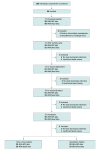Longitudinal Associations of Clinical and Biochemical Head Injury Biomarkers With Head Impact Exposure in Adolescent Football Players
- PMID: 37252737
- PMCID: PMC10230318
- DOI: 10.1001/jamanetworkopen.2023.16601
Longitudinal Associations of Clinical and Biochemical Head Injury Biomarkers With Head Impact Exposure in Adolescent Football Players
Abstract
Importance: Consequences of subconcussive head impacts have been recognized, yet most studies to date have included small samples from a single site, used a unimodal approach, and lacked repeated testing.
Objective: To examine time-course changes in clinical (near point of convergence [NPC]) and brain-injury blood biomarkers (glial fibrillary acidic protein [GFAP], ubiquitin C-terminal hydrolase-L1 [UCH-L1], and neurofilament light [NF-L]) in adolescent football players and to test whether changes in the outcomes were associated with playing position, impact kinematics, and/or brain tissue strain.
Design, setting, and participants: This multisite, prospective cohort study included male high school football players aged 13 to 18 years at 4 high schools in the Midwest during the 2021 high school football season (preseason [July] and August 2 to November 19).
Exposure: A single football season.
Main outcomes and measures: The main outcomes were NPC (a clinical oculomotor test) and serum levels of GFAP, UCH-L1, and NF-L. Participants' head impact exposure (frequency and peak linear and rotational accelerations) was tracked using instrumented mouthguards, and maximum principal strain was computed to reflect brain tissue strain. Players' neurological function was assessed at 5 time points (preseason, post-training camp, 2 in season, and postseason).
Results: Ninety-nine male players contributed to the time-course analysis (mean [SD] age, 15.8 [1.1] years), but data from 6 players (6.1%) were excluded from the association analysis due to issues related to mouthguards. Thus, 93 players yielded 9498 head impacts in a season (mean [SD], 102 [113] impacts per player). There were time-course elevations in NPC and GFAP, UCH-L1, and NF-L levels. Compared with baseline, the NPC exhibited a significant elevation over time and peaked at postseason (2.21 cm; 95% CI, 1.80-2.63 cm; P < .001). Levels of GFAP and UCH-L1 increased by 25.6 pg/mL (95% CI, 17.6-33.6 pg/mL; P < .001) and 188.5 pg/mL (95% CI, 145.6-231.4 pg/mL; P < .001), respectively, later in the season. Levels of NF-L were elevated after the training camp (0.78 pg/mL; 95% CI, 0.14-1.41 pg/mL; P = .011) and midseason (0.55 pg/mL; 95% CI, 0.13-0.99 pg/mL; P = .006) but normalized by the end of the season. Changes in UCH-L1 levels were associated with maximum principal strain later in the season (0.052 pg/mL; 95% CI, 0.015-0.088 pg/mL; P = .007) and postseason (0.069 pg/mL; 95% CI, 0.031-0.106 pg/mL; P < .001).
Conclusions and relevance: The study data suggest that adolescent football players exhibited impairments in oculomotor function and elevations in blood biomarker levels associated with astrocyte activation and neuronal injury throughout a season. Several years of follow-up are needed to examine the long-term effects of subconcussive head impacts in adolescent football players.
Conflict of interest statement
Figures




References
Publication types
MeSH terms
Substances
Grants and funding
LinkOut - more resources
Full Text Sources
Medical
Miscellaneous

